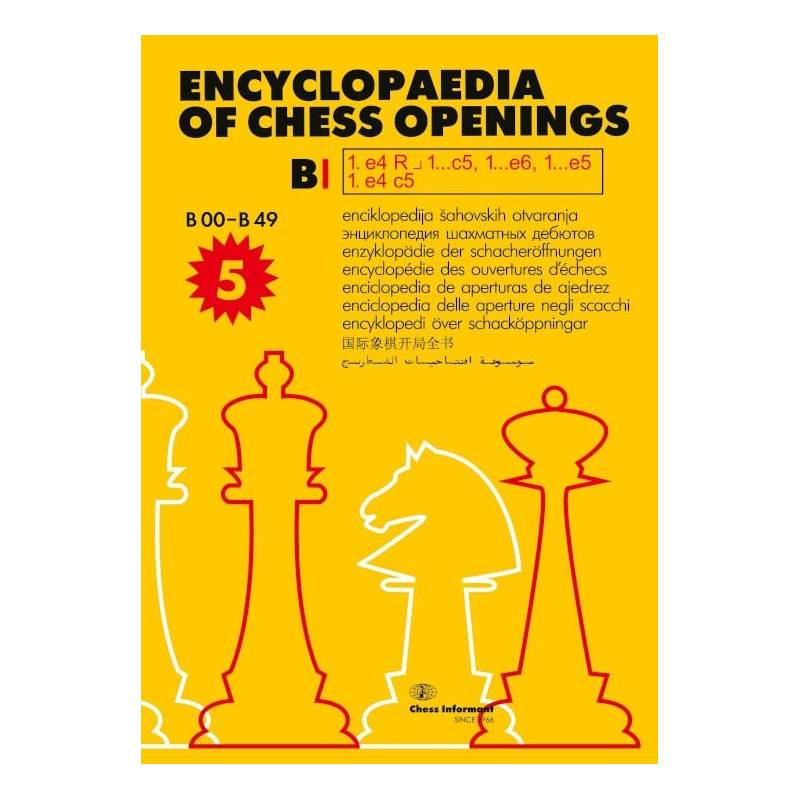Szachy Senator (S-15)
Szachownica i figury wykonane są z drewna.
Wymiary: 420 x 210 x 50 mm
Król: 78 mm
Waga 1.60 kg
Szachownica i figury wykonane są z drewna.
Wymiary: 420 x 210 x 50 mm
Król: 78 mm
Waga 1.60 kg
PROFESJONALNE SZACHY TURNIEJOWE ( rozmiar szachownicy oraz figur zgodny w wytycznymi Polskiego Związku Szachowego oraz FIDE)
Szachy drewniane, składane ze specjalna kasetką na figury.
Figury turniejowe Staunton nr 5, obciążone, podklejane filcem.
Szachownica intarsjowana naturalny mahoń
Wymiar szachownicy: 47 x 47 x 2,5 cm;
Wymiar pola szachowego: 48 x 48 mm;
Wysokość króla: 93 mm; pionek: 4,5 cm;
Waga łączna: 2,00 kg;
Kompletny zestaw dwóch części książki Mistrzowie Polski w Szachach obejmujący biografie polskich szachistów grających w latach 1926 - 2021r.
Autor przygotował materiał, który zawiera propozycje gry wariantów przeciwko debiutom otwartym i półotwartym. Każdemu debiutowi autor poświęcił tyle miejsca, na ile zasługuje ze względu na bogactwo wariantów i częstość jego występowania w praktyce turniejowej.
Najniższa cena w ciągu 30 dni przed aktualną promocją: 1477 zł
Pięknie zaprojektowany nowy komputer szachowy z niezwykle dokładnymi czujnikami dotykowymi, które bez trudu rejestrują ruchy.
Zestaw posiada akumulator, wyświetlacz, intuicyjne ustawienia w wielu językach (w tym język POLSKI) i obciążane plastikowe szachy. Ruchy komputera są wskazywane przez unikalne okrągłe diody LED.
Jego największą zaletą jest adaptacyjny inteligentny program szachowy, który automatycznie dostosowuje się do siły gry, aby zawsze mieć odpowiedniego partnera do gry.
Czapka zimowa z szachowymi motywami.
Piękna, ciepła czapka zimowa z przyjemnego w dotyku materiału, wyszyta wewnątrz polarem to wspaniały prezent na Mikołajki lub inną okazję, ale także świetne uzupełnienie dziecięcej (i nie tylko garderoby). To niebanalny dodatek, który przełamie i rozweseli każdą stylizację.
Wymiary:
Szerokość: 25 cm (obwód 50 cm)
Głębokość: 20 cm
Atrakcyjnie wyglądająca pamięć USB w kształcie króla
Wykonanie: drewno egzotyczne
Pojemność: 64 GB
Wymiary:
- wysokość: 90 mm
- średnica: 30 mm
Nowe rozszerzone wydane - 2020 r. II wydanie., 280 str., miękka oprawa, dobra poligrafia , język polski.
Cytat I ze Wstępu: „Szybki Kurs Debiutów omawia przede wszystkim otwarcia w jednym tomie i jest przeznaczony przede wszystkim dla szerokiej rzeszy sympatyków królewskiej gry. Dzięki niej każdy może szybko zapoznać się z ogólnymi tajemnicami teorii otwarć, głównymi ideami i planami, co wydatnie pomoże w rozgrywaniu partii”.
Cytat II: „Każda faza partii, otwarcie, gra środkowa i końcowa ma duże znaczenie. Jeżeli na początku gry, któraś ze stron uzyska przewagę materialną lub pozycyjną, to zniwelować ją w grze środkowej będzie bardzo trudno. W tej sytuacji do końcówki może w ogóle nie dojść. Bez poprawnej gry w debiucie, nie można więc myśleć o sukcesach w szachach.
Najlepiej sprzedające się szachy od lat.
Najlepszy stosunek jakości do ceny.
Szachownica i figury wykonane z drewna.
SZACHOWNICA wypalana, składana na pół,
w środku znajduje się wkładka na figury szachowe
FIGURY drewniane, wypalane, podklejane zielonym filcem
Wymiary szachownicy: 54 x 54 x 3 cm
Wymiar pola: 55 x 55 mm
Król: 110 mm
Waga 2.50 kg
DGT 1002 to najprostszy z dostępnych na rynku zegarów szachowych z opcją "BONUS" (dodawanie czasu za wykonane posunięcie). Jest niezwykle łatwy w obsłudze i bardzo przyjemny w użyciu. Wystarczy nacisnąć + lub -, aby ustawić pożądany czas.
Ze względu na niewielki rozmiar zegara, można go postawić przy samej szachownicy nawet nawet na małej przestrzeni na stole.
Wymiary zegara:
• długość 155 mm,
• szerokość 42 mm,
• wysokość 60 mm.
DGT 1002 pracuje na tylko jednej baterii (dołączonej do zestawu).
Na zegar udzielana jest 2-letnia gwarancja.
Doskonały zegar w prostej formie, prosty w obsłudze z dużym, czytelnym wyświetlaczem - idealny dla każdego gracza.
Polecany dla szkół i klubów szachowych.
Uwaga: bierki warcabowe nie są magnetyczne.
Kieszonkowe Szachy Magnetyczne w NOWEJ ODSŁONIE 2.0
Tym razem – składane na 3, dzięki czemu zyskały miejsce na "zbite" figury.
Dodatkowo wprowadzono notację, której brak czasem krytykowano w poprzedniej edycji.
Poręczny towarzysz w podróży w Twojej kieszeni!
Od dziś możesz grać w szachy gdziekolwiek i kiedykolwiek zechcesz!
- Idealne do analizy partii!
- Szachy wykonane są z tworzywa sztucznego.
- Zewnętrzna strona zrobiona została z ekoskóry.
- Materiał: Vinyl, ekoskóra, plastik
SZACHY TURNIEJOWE NR 5 - CZEREŚNIOWE
Drewniane figury Staunton nr 5 z drewna czereśniowego - obciążone, podklejone zielonym filcem
- Wysokość króla - ok. 90 mm;
- Wysokość pionka - ok. 45 mm
Szachownica drewniana, składana na pół z miejscem na figury w środku.
- Wymiar szachownicy: 48 x 48 x 2,7 cm;
- Wymiar pola szachowego: 48 x 48 mm;
Waga łączna: 1.7 kg;
SZACHY TURNIEJOWE w kolorze WENGE NR. 5
Klasyczny, profesjonalny zestaw turniejowy w rozmiarze nr 5 (48x48 cm)
Ciemny kolor zestawu sprawia, że szachy prezentują się bardzo oryginalnie.
Edycja LIMITOWANA jednego z najlepszych elektronicznych zegarów szachowych DGT 3000 została wydana z okazji 25-lecia firmy DGT.
Od wersji standardowej zegara różni go ekskluzywny wygląd - wygląda jak by był wykonany z drewna!
Pozostałe parametry nie zostały zmienione.
Szachownica i figury wykonane są z drewna.
Wymiary: 420 x 210 x 50 mm
Król: 78 mm
Waga 1.60 kg
Produkt dostępny wyłącznie w formie pobrania
Nowe książeczki ChessBase zawierają kod aktywacyjny, który umożliwia pobranie produktu. ChessBase 18 oraz nowe bazy danych nie będą już wydawane na DVD-ROM. Szczegóły na końcu opisu.
ChessBase to samodzielna baza danych szachowych, która stała się światowym standardem. Korzystają z niej wszyscy – od mistrzów świata po amatorów. Jest to ulubiony program każdego miłośnika szachów, który chce poszerzyć swoją wiedzę i umiejętności. Rozpocznij swoją osobistą przygodę z sukcesami dzięki ChessBase i ciesz się grą jeszcze bardziej.
Szachy drewniane turniejowe w rozmiarze idealnie dopasowanym do dzieci w wieku 6-10 lat !!
Figury szachowe - drewniane, wykonane w klasycznym kształcie.
Zastosowany rozmiar figur to idealne rozwiązanie dla dzieci, które zaczynają swoją przygodę z królewską grą.
Szachownica - klasyczna składana na pół szachownica w formie zamykanej kasetki, wewnątrz której znajdziemy miejsce na figury.
Dzięki temu, że szachownica jest składana i można w niej przechowywać figury, zestaw jest prosty w użyciu i transporcie.
Szachy idealnie sprawdzą się jako narzędzie treningowe, które można mieć właściwie zawsze przy sobie.
Drewno: Grab, Buk, Akacja
Waga zestawu: ok.1 kg
WYPRODUKOWANE W POLSCE!
Kompletna edycja książek z serii WESOŁE SZACHY wydana w jednym podręczniku.
Ten kompleksowy podręcznik dla najmłodszych szachistów zawiera nie tylko wszystkie 3 części "Wesołych Szachów, ale także część 4 - czyli całkowitą nowość, dotychczas nigdy nie wydaną!
Figury szachowe STAUNTON 6 w kasetce drewnianej + deska drewniana nr6
Figury szachowe turniejowe, drewniane, obciążane, podklejane filcem, wkładane do kasetki drewnianej
Wysokość króla 98mmm.
Deska drewniana, intarsjowana
Wymiary: 55x55x2cm
Wymiary pola: 56 x 56 mm
Waga łączna 4,00 kg
Half a century ago the first edition of the Encyclopaedia of Chess Openings was released, as a truly unique, ground-breaking tome. Such monumental work was a logical continuation to the Informant series which came to life a few years earlier. Chess Informant introduced a completely revolutionary system of chess signs, and also created the classification of chess openings, according to codes (ECO codes). Today Chess Informant’s ECO Codes and System of Signs are integral parts of the universal chess culture and heritage.
Over the years, and subsequent editions of five ECO tomes (A, B, C, D and E) all the greatest chess players and analysts contributed to the Encyclopaedias, each focusing on the sections which they were most acquainted with, producing astounding analyses and recommendations.
Eighteen years passed since the previous edition of the Encyclopaedia of Chess Openings - Volume B was released. We tried to keep all the major qualities of the previous ECO Volumes intact, but to make the book easier to read and browse through, especially when used as a source of reference. The material we gathered was so rich in details and nuances, so ultimately we decided to publish the ECO B Volume in two parts. We are positive that omitting any of the lines would be a terrible shame, so you will have the pleasure of reading and digesting the material in its completeness.
Finally, we are sure that the human touch should remain crucial, so all the members of the editorial crew gave their absolute best in researching, analysing, evaluating and suggesting lines of the greatest value and strength, thus allowing you to read the book and apply the lines in your own games with complete confidence.
ECO B - Part I contains detailed coverage of ECO codes 00-49

Gwarancja zwrotu pieniędzy

Bezpieczne i szybkie dostawy

Bezpieczeństwo transakcji dzięki certyfikatowi SSL
B00 King's Pawn Opening
B01 Scandinavian Defence
B02-05 Alekhine's Defence
B06 Robatsch (Modern) Defence
B07-09 Pirc Defence
B10-19 Caro-Kann Defence
B22 Sicilian Defence, Alapin Variation, 2.c3
B23-26 Sicilian Defence, Closed Variation, 2.Nc3
B33 Sicilian Defence, Lasker/Sveshnikov Variation
B34-39 Sicilian Defence, Accelerated Fianchetto
B40-49 Sicilian Defence, Paulsen-Kan/Taimanov Variation
Half a century ago the first edition of the Encyclopaedia of Chess Openings was released, as a truly unique, ground-breaking tome. Such monumental work was a logical continuation to the Informant series which came to life a few years earlier. Chess Informant introduced a completely revolutionary system of chess signs, and also created the classification of chess openings, according to codes (ECO codes). Today Chess Informant’s ECO Codes and System of Signs are integral parts of the universal chess culture and heritage.
Over the years, and subsequent editions of five ECO tomes (A, B, C, D and E) all the greatest chess players and analysts contributed to the Encyclopaedias, each focusing on the sections which they were most acquainted with, producing astounding analyses and recommendations.
Eighteen years passed since the previous edition of the Encyclopaedia of Chess Openings - Volume B was released. We tried to keep all the major qualities of the previous ECO Volumes intact, but to make the book easier to read and browse through, especially when used as a source of reference. The material we gathered was so rich in details and nuances, so ultimately we decided to publish the ECO B Volume in two parts. We are positive that omitting any of the lines would be a terrible shame, so you will have the pleasure of reading and digesting the material in its completeness.
Finally, we are sure that the human touch should remain crucial, so all the members of the editorial crew gave their absolute best in researching, analysing, evaluating and suggesting lines of the greatest value and strength, thus allowing you to read the book and apply the lines in your own games with complete confidence.
ECO B - Part II contains detailed coverage of ECO codes 50-99
BRAK NA MAGAZYNIE - produkt może zostać sprowadzony "NA ZAMÓWIENIE"
Playing the Modern Defense with any regularity is a sign that you truly love chess. From the very first move, you are indicating to your opponent (and to the jury deciding on the brilliancy prizes!) that you would like to play an unbalanced position. Then the thrill of the fight courses through your veins and you simply must trust yourself to handle developments better than the other player. For a very long time this truly was the absolute frontier, the Wild West of opening theory: if it went well you looked like a genius, if it goes badly you got mated in 20 moves, and most likely neither of you ever really made the analysis which you so badly needed to remember at the board.
A certain air of reckless abandon, of pure devil-may-care mischief, was needed to play it successfully, and to some extent still is. Something of this passion was conveyed into printed form by Swedish GM Tiger Hillarp Persson when he wrote his Tiger’s Modern. Even within the Modern, the crème de-la-crème of the opening, when I learned it from his book almost a decade ago was the famous Hippo setup, the epitome of the adventurer’s spirit.
While White goes about stationing his pieces aggressively, controls the centre, etc., Black nonchalantly places nearly all his pawns on the third rank and shuffles his pieces behind them! For some reason this appealed to the 15-year-old me: the idea that I could take the game to my opponent in a way that I chose, rather than by preparing endlessly for some subtlety on move 27 of the Poisoned Pawn Najdorf.
Throughout the year 2010 I played the Modern almost exclusively; it filled the gap between my 1 ... e5 phase and my 1 ... c6 phase. (The latter remained my main reply to 1.e4 until I began learning the Najdorf in 2018, but I do still enjoy regularly mixing it up with the Modern; there are more than 20 references to my own games in the text.) What might surprise you is that 2010 was the year in which my chess career started progressing by leaps and bounds! I became an IM relying very heavily on it; an example from one of my norm tournaments can be seen in Part I (Lahiri-Fernandez.) I embraced the complexity, the audacity and the novelty whole-heartedly, and it embraced me back.
King’s Indian 2 is the concluding volume of a complete repertoire for Black. GM Gawain Jones is the ideal guide, as a world-class player and longstanding expert on the King’s Indian. This book version of Jones’s Chessable course has been extensively edited and reorganized by Quality Chess.
BRAK NA MAGAZYNIE - produkt może zostać sprowadzony "NA ZAMÓWIENIE"
The King’s Indian Defense has a reputation as a sharp combative opening where Black aims to attack on the kingside, usually through a pawn storm supported by heavier artillery.
The Sicilian Sveshnikov arises after the opening moves 1.e4 c5 2.Nf3 Nc6 3.d4 cxd4 4.Nxd4 Nf6 5.Nc3 e5, and is an ideal weapon based on sound principles of fast development and seizing central space. Decades of practical testing and analysis have proved the theoretical soundness of Black’s system, and its dynamic counterattacking potential makes it a popular choice among club players and top grandmasters alike.
In my first volume of the Anti-Sicilians, we will be examining the Rossolimo variation. The Sveshnikov and Classical Sicilians, where Black begins with 2 ... Nc6, have consistently been a popular way for Black to acquire counter-attacking chances straight from the opening. These openings are the favorites of many top level Grandmasters; none more so than Magnus Carlsen, who most famously fashioned the Sveshnikov Sicilian against Fabiano Caruana in the 2018 World Championship match. The Rossolimo variation with 3.Bb5 is the clearest indication that we are attempting to frustrate Black’s counterplay. By delaying opening the center, we can simply wait for Black to show us how he intends to continue before we make any big commitments. Most importantly, we have the positional threat of Bxc6, which Black has to be wary of if he himself tries to open the center too quickly. In nearly all variations our principal aim is to achieve rapid development, ensuring optimal conditions for a timely central break. In the main three systems (3 ... d6, 3 ... e6 and 3 ... g6), my multiple suggestions are based on the dual concepts of playing as actively as possible, whilst simultaneously frustrating Black’s ideals.









